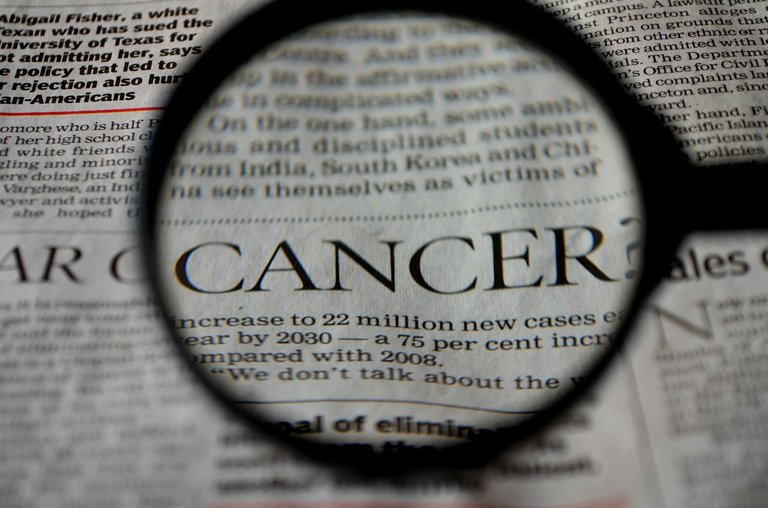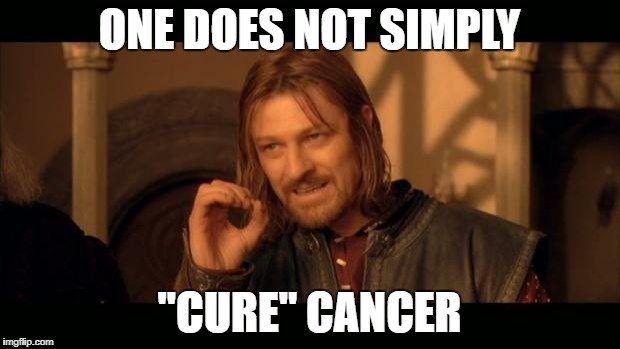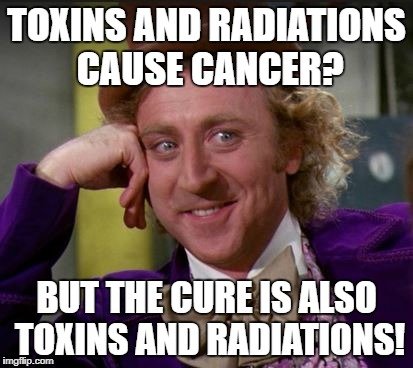Even after several billions of Dollars and decades of research, we are yet to find a way to cure the various forms of cancer. There are several drugs and treatments available, but many of them don't work for certain people. It often happens that one treatment worked for a person but it failed completely for another person having the same type of cancer. Why is it so difficult to find the cure for cancer? Actually, it is wrong to talk about "the" cure for cancer, because cancer is not a single disease, there are several types of cancer and each has its own completely different way of growing. To understand this, let's begin with what cancer is.

Source: pixabay.com
What is cancer?
While each cancer is different, the one thing that is common between them is uncontrolled cell division. This happens due to change, called mutation, in a set of genes, of a few cells, which control the cells division rate. This mutation can be due to many causes like chemicals to radiations. Whatever the cause behind this mutation, the end result is the uncontrolled division of cells which displaces other tissues, which is very harmful to the body.
The problem is that each type of cancer is caused by a different set of genetic mutation. Genes are a sequence of nucleotides or proteins, the sequence of which decides or tells the cell what protein and what quantity of it is to be produced by the cell. All life as we know it works on the basis of proteins. Mutations change the sequence of these nucleotides which garbles up instructions for the cell thus causing the cell's protein production system to go haywire.
While most of the times, mutations cause the cell to die and are practically harmless, however, sometimes these mutations occur in growth and tumour suppressor genes. Oncogenes are the mutated version of growth genes which cause the cell to create proteins which make the cell to grow. These growth genes are mostly dormant because the cell doesn't need to grow all the time. But mutations can result in making these genes into oncogenes which send signals(proteins) for the cell to grow, causing uncontrolled cell division. Normally growth genes also have a corresponding gene which tells the cell to stop growing. But often the mutation is such that genes which are supposed to end the process of growing, fail to recognize the new kind of growth protein and hence can't stop the process of growth.

Source:Katie McKissick, Beatrice the Biologist
Tumor suppressor genes have the opposite job. They stop the cell from growing unless it has been given the precise instruction to not do so. Every cell has two copies of the tumour suppressor, so even if one of them is mutated, the other works fine. However, it so happens that the cell somehow loses a part of the DNA which had the still functional tumour suppressor gene. This results again in uncontrolled growth. Given the number of different possible mutations, it is difficult to guess which drug would be useful in preventing the mutation. Moreover, it usually takes 4 or 5 mutations for the cell to be cancerous. This makes it even more difficult. As the cancer progresses, more and more mutations occur, often taking a nastier turn. The rate and type of these is dependent on the type of mutation and the location.
In short, every cancer is different and this makes it difficult for doctors and scientists to know what to target!
Curing Cancer
So, how do we treat the cancer if we don't know what exactly it is? One of the most common ways is resecting which is basically cutting out the tumour or the mutated cells. But it is not always possible and often even if it is cut out, a few cancer cells sometimes remain, for eg. due to getting flown away in the blood stream, and again start to regenerate.

Source: Self made using imgflip.com
Another method to eliminate the cancer cells is to target a wide range of criterias satisfied by cancer cells even if normal cells might get affected. The most common ways are chemotherapy and radiation treatment.
Chemotherapy usually involves taking drugs which kill all rapidly dividing cells, therefore preventing the cancer cells from growing. However, this also causes the death of some rapidly dividing healthy cells like hair follicles which cause the hair to grow, thus resulting in hair loss. Chemotherapy drugs usually work by one of the following methods:
- Prevent cell division like in case of cytotoxic drugs
- Prevent the cells from getting their food source by blocking enzyme and hormone pathways
- trigger apoptosis or suicide of cells
For Chemotherapy to work, we need the right type of drug for the kind of cancer and for the type of mutation.

Source: Self made using imgflip.com
Radiation treatment or therapy involves using high energy radiation to kill the cancer cells in a tumour. They actually destroy normal cells too, but the radiation is mostly localized on the cancer cells. Radiations kill the cells by destroying the DNA of the cell thus preventing the cell from carrying out basic functions. The radiation can be delivered externally via machines or internally by placing a radioactive substance inside the body near the tumour.
Many a times the cancer "metastasises", that is, it spreads to various parts of the body and starts forming tumours there. The most common way for this to happen is for a few cells to break away and travel in the circulatory system and end up somewhere else. This results in tumours where they end up. Apart from this, it is also sometimes difficult to use radiation in places where the damage to neighbouring cells is too risky or problematic. Thus manually killing them by radiation isn't always viable.
One of the latest methods to treat cancer is by using genome sequencing. Genome sequencing can tell where and how the DNA is mutated. So, theoretically we can use this knowledge to find the right kind of drug for each case of cancer. This process has been developed to be quite fast and quite cheaper as compared to that a few years ago, however, a problem still remains. Two well-known projects for genome sequencing are Cancer Genome project and the Cancer cell line encyclopaedia. They have tested several kinds of drugs for various types of mutatuons. The problem is that both these projects have arrived at different results several times for the same kind of drug and the same kind of mutation. Even in cases where the drugs were identified to be effective by both the groups, there have been several cases where they disagree on the amount of drug to be prescribed. Thus for genome sequencing to work we need better ways to test these drugs and better ways to see how they would actually work in humans. But, all in all this is the most promising way to treat cancer.
So, to conclude, Cancers are not one disease. At the moment, treatments like chemotherapy and radiation therapy are available but aren't effective in frequently. But advances in techniques like genome sequencing can lead to drugs/medicines for each of these cancers.
References
- Oncogenes and Cancer
- The Hallmarks of Cancer
- Hallmarks of Cancer: The Next Generation
- Radiation Therapy for Cancer
- What you need to know about chemotherapy
- 10 questions about chemo and hair loss
- Technology: The $1,000 genome
- Inconsistency in large pharmacogenomicstudies
Phew! This post took me a very long time to complete... thanks to my busy schedule. It had been incomplete in my draft for a few weeks now.
I write posts mostly in the steemSTEM category. Check out some of my old posts:
- Can you measure the radius of Earth by yourself? Yes, you can! See how here.
- Can you tell, how to shout a secret message to a stranger in public and understand each other while that nobody else has a clue? Here's how you can!
- Read about how clocks and Mathematics are closely related in my old post: Clocks and Mathematics
Follow me @omstavan for more such posts.

Thanks to @rocking-dave for this SteemSTEM banner.
Being A SteemStem Member
I do believe that beatrice picture is copyright protected. Your best bet would be to drop a quick email for permission
Ok. I am going to email her. I will remove it for the time being and add it back if she agrees. Thanks for letting me know.
Man! the post looks a bit boring without that image! :(
well you didn't need to delete it, just will withold upvotes until confirmation confirmed ^__^
She gave her permission! :D Yay!
I loved how complete this article is. Congratulations, really very good. Greetings. Following you
Thanks!
I really liked it!
I was actually expecting a couple of names like TNF-α (Tumor Necrosis Factors alpha) for inhibition of tumorigenesis or names for mutations that cause cancer like mutation of the BRCA1/BRCA2 genes (for Breast Cancer).
Otherwise, really straight to the point, easy to understand and well redacted. Continue like that!
Well, it is generally preferable to keep things simple so that most people find it easy to understand. Also posts become too boring. Thanks for your comment! :)